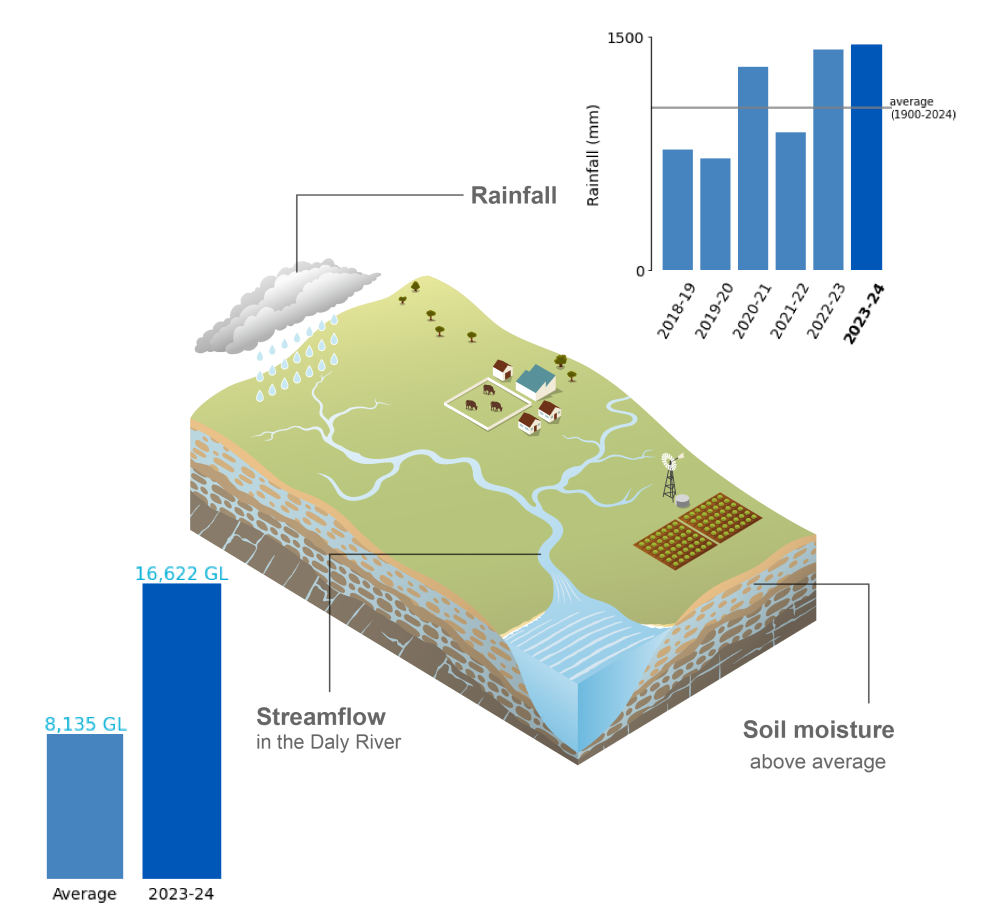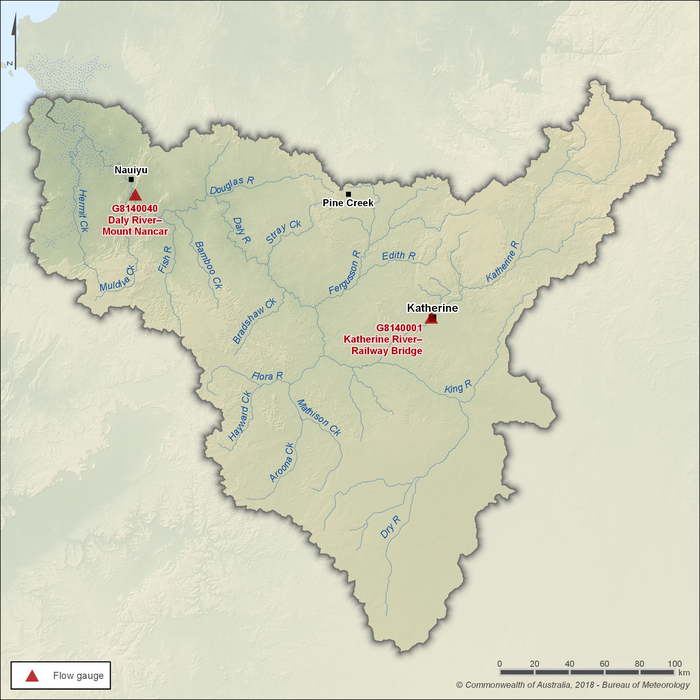Daly: Climate and water
For the water account period 1 July 2023 to 30 June 2024
- Annual rainfall in the Daly region during 2023–24 was the sixth highest on record, more than 99% of which fell during the wet season, contributing to the region’s third-wettest two-year period on record.
- Soil moisture in the root zone (0–1 m depth) was above average across most of the region, particularly during the latter part of the wet season, following the region’s wettest January–to–March period on record.
- Total annual flows in the Daly and Katherine rivers were the fourth and ninth highest on record, respectively.
- Groundwater levels in the Tindall Limestone and Oolloo Dolostone aquifers increased during 2023–24, primarily due to enhanced recharge following widespread rainfall.

For further information on the region's climate and water conditions during the 2023–24 year scroll down this page or click on the links below:
About the region
- The Daly region experiences a tropical climate, characterised by hot, humid summers and warm, dry winters.
- Almost all rainfall in the Daly region occurs between October and April, during the northern wet season.
- Most of the annual streamflow occurs during the wet season; however, the Daly River is one of the few perennial rivers in northern Australia. During the dry season (May to September), flow in the Daly River is largely sustained by discharge from the Tindall Limestone and Oolloo Dolostone aquifers.
Climate conditions
Rainfall
Figure C1 Annual and monthly rainfall deciles for the Daly region during the 2023–24 year
- Total area-averaged rainfall in the Daly region during 2023–24 was 1,453 mm, 40% above the long-term average of 1,039 mm, making it the region’s sixth-wettest year on record, contributing to the region’s third-wettest two-year period on record.
- Little rainfall occurred from July to September, which is typical for this time of year in the Daly region.
- In late September, a positive Indian Ocean Dipole (IOD) and an El Niño event in the tropical Pacific Ocean were declared underway (as stated in this Climate Driver Update). Historically, concurrent positive IOD and El Niño events increase the likelihood of below-average rainfall during winter and spring, and can delay the onset of the wet season.
- Widespread showers and thunderstorms impacted the region throughout November, delivering above-average rainfall, and officially marking the start of the wet season.
- An active monsoon trough and embedded tropical low produced heavy to locally intense rainfall and flooding across the Daly region in January, with weekly totals exceeding 300 mm. This resulted in the region’s second-wettest January on record.
- By late January, the positive IOD returned to neutral, while the El Niño event began weakening through autumn. Despite this, another tropical low embedded in the monsoon trough impacted the region in February, bringing weekly totals of up to 200 mm. While rainfall was high, February was only 14% above the long-term monthly average.
- A third low-pressure system and associated monsoon trough brought further showers and thunderstorms in March, delivering weekly totals of 100–200 mm across parts of the region. This contributed to the seventeenth-wettest March on record, with monthly rainfall 73% above average, and resulted in the wettest January–to–March period on record.
- At the end of autumn, the El Niño–Southern Oscillation returned to neutral, with its influence on the region’s climate gradually waning, but despite the presence of a positive IOD and El Niño event during the 2023–24 wet season, it was the region’s sixth-wettest wet season on record, accounting for almost all rainfall observed during the reporting year.
- More information on the northern wet season and Australia's climate and water during the 2023–24 reporting year can be found in Australia's 2023–24 Northern Wet Season and Financial Year Climate and Water Statement 2023–24.
Figure C2 Total monthly rainfall for the Daly region during the 2023–24 year compared with the average and percentiles for the region
- January was the only month where rainfall exceeded the 90th percentile, while March was just below the 90th percentile. Rainfall in November and February was also above average.
- During the wet season, rainfall in October, December, and April was below average, although none of these months fell below the 10th percentile.
- Outside the wet season, rainfall remained typically low across the region.
Actual evapotranspiration
Figure C3 Annual and monthly actual evapotranspiration deciles for the Daly region during the 2023–24 year
- Total area-averaged actual evapotranspiration was above average across most of the Daly region during 2023–24, following the region’s sixth-wettest year on record.
- With near-average rainfall leading into the 2023 dry season, actual evapotranspiration from May to September was predominantly average to above average.
- Actual evapotranspiration remained average across most of the region during October and November, following a slow start to the 2023–24 wet season.
- Widespread showers and thunderstorms during November, marking the official start of the wet season, increased water availability and actual evapotranspiration across the region in the lead-up to summer.
- Despite the region's second-wettest January on record, actual evapotranspiration was below average across much of the region due to persistent cloud cover.
- High rainfall throughout summer and into autumn maintained water availability across the region, and with increased sunshine, actual evapotranspiration remained predominantly above average from February through to the end of the reporting period.
Soil moisture
Figure C4 Annual and monthly soil moisture deciles for the Daly region during the 2023–24 year
- Soil moisture in the root zone (0–1 m depth) was above average across most of the region during 2023–24, following its sixth-wettest year on record.
- Although little rainfall occurred during the dry season, soil moisture was predominantly average to above average in July and August. However, with limited rainfall until November, soil moisture gradually declined, becoming predominantly average to below average leading into the 2023–24 wet season.
- Widespread showers and thunderstorms in November and December caused soil moisture to rebound, becoming average to above average by the start of summer.
- Several monsoonal bursts during summer contributed to the region’s wettest January–to–March period on record, further increasing soil moisture across much of the region.
- Despite very little rainfall following the conclusion of the 2023–24 wet season, soil moisture remained average to above average through to the end of June.
- More information on the soil moisture conditions across the Daly region during the 2023–24 reporting year is available on the Australian Water Outlook.
Flow responses
Streamflow

Figure C5 Key flow gauging stations along the main rivers within the Daly region
- The Katherine and Daly rivers are the two primary river systems in the Daly region, with the Katherine River acting as the main tributary to the Daly River—one of the larger river systems in the Northern Territory.
- Two gauging stations—Katherine River at Railway Bridge (Station G8140001) and Daly River at Mount Nancar (Station G8140040)—are used to represent seasonal flow patterns in the region’s rivers.
- Although streamflows are strongly influenced by annual rainfall patterns, the Daly River is one of the few perennial rivers in northern Australia. Its year-round flow is sustained by groundwater discharge from the Tindall Limestone and Oolloo Dolostone aquifers, which are separated by an intervening siltstone aquitard.
Figure C6 Total monthly flow for major rivers in the Daly region during the 2023–24 year compared with the average and percentiles
- Total annual flows in both the Daly and Katherine rivers were above average in 2023–24, following the region’s sixth-wettest year on record.
- Flows in the Daly River at Mount Nancar (Station G8140040) were the fourth highest on record, recording more than twice the long-term annual average of 8,135 GL. Similarly, flows in the Katherine River at Railway Bridge (Station G8140001) were the ninth highest on record, at 58% above the long-term average of 2,280 GL.
- With little rainfall from July to October, streamflows at both sites remained near baseflow levels.
- Following the region’s second-wettest January on record, streamflows rose sharply at both sites, with the Daly River peaking above the 90th percentile.
- On the back of the region’s wettest January–to–March period on record, streamflows at both sites reached their highest levels of the year, peaking near or above the 90th percentile in March.
- After the conclusion of the 2023–24 wet season, streamflows at both sites declined rapidly, returning to baseflow volumes by the end of June, as is typical for these river systems.
Groundwater level
- The Tindall Limestone and Oolloo Dolostone aquifers are important groundwater stores that provide dry season flow for parts of the river system. The aquifers are also a primary source for consumptive water supply.
- A key groundwater level monitoring bore for the Tindall Limestone Aquifer is located near Katherine, while a key bore for the Oolloo Dolostone Aquifer is located near the junction of the Douglas and Daly rivers.
Figure C7 Groundwater level in key bores within the Daly region from 2014–2024
- Groundwater levels in the Tindall Limestone and Oolloo Dolostone aquifers increased during 2023–24 due to significant recharge following the region’s sixth-wettest year on record.
- From July to December, groundwater levels gradually declined due to a lack of significant rainfall to support recharge.
- In January, the first monsoonal burst of the 2023–24 wet season brought widespread thunderstorms, delivering up to 300 mm of rainfall across the region. This resulted in groundwater levels rising by up to two metres in the Tindall Limestone and Oolloo Dolostone aquifers.
- Additional monsoonal bursts in February and March further raised groundwater levels in both aquifers.
- By March, groundwater levels in both aquifers had reached saturation, rising above the surface and contributing to flooding across parts of the region.
- More information on Daly's groundwater resources can be found in the Region description.
Note: data at the Oolloo Dolostone aquifer was only available until the 5 March 2024.









